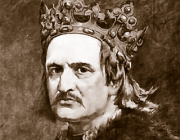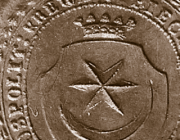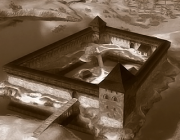What to see in Kreva besides the castle?
Where to look for the best view over the township and why the Kreva stones are so remarkable

Unfortunately, most of the significant sites in Kreva were lost. We know about them from the old documents and photos, local toponyms and legends. The ones which have been preserved are in poor condition. Yet, they stay mysterious and captivating. The most popular among tourists is the Kreva Castle. Although there are only ruins left from it, they witnessed the history unfolding here over the centuries and remember the people who created it.
Transfiguration of Christ Church

Not less interesting than the castle is the Kreva Church. The modern building appeared in the 1990s. The initial church, however, was founded in 1387 when Jogaila, the Grand Duke of Lithuania, converted to Catholicism and promised to spread it over the Belarusian lands. The church was many times closed, destroyed, rebuilt for various needs. For example, at the end of the 19th century it was turned into the Holy Trinity Orthodox Church which was completely ruined during World War One. When Kreva was part of Poland, a new wooden church was erected on this site. In the Soviet times it was closed and accommodated for a hospital. In the mid ‘90s the church was restored, and now the building made of stone amazes with its beauty and reminds of the rich history of Catholicism in Kreva.
Kreva Hillfort

This site is even more ancient that both the castle and the church. The hillfort impresses with its grandeur. It’s worth walking up to the top and along the earthworks. In the ancient times there stood wooden fortifications. Before there had appeared the stone-built castle the hillfort functioned as a residence for the local duke. During invasions of the enemy the local population was hiding inside. In the middle of the hillfort there was a deep well which helped withstand a long siege. Its remains could still be found in the 19th century. The excavations in the place of the hillfort proved that it had existed at least from the 10th till the 13th century.
The Great Stone of Kreva

It is a natural monument of the republican significance. The stone can be found close to the hillfort. It is massive, and part of it kind of sank into the soil. The stone weighs over 50 tons. The length of one of its axes is 3.9 meters, the height is 1.4 meters. This stone is believed to have drifted here with the ice cap from Finland.
The River Kraulianka

The hillfort and the Great Stone of Kreva are situated near the head of the river Kraulianka. It starts with a small spring and along the following 20 km it carries its waters into the Western Biarezina. The Kraulianka has also witnessed all the events taken place in Kreva. In the autumn of 1915 the river became a borderline between German and Russian positions during World War One.
The Mass Grave of the Russian Soldiers

It is located on the western bank of the Kraulianka which was at some point occupied by the German side. It is a burial place of the Russian soldiers who perished during the First World War. In 1966 the local historian Piotr Hrynkevich put up a memorial stone on the mass grave. According to him, 154 soldiers were buried there.
In 1996 a cross was put up and blessed on the site. Later the remains of the Russian soldiers found in the vicinities were reburied in this grave.
Fortifications of the First World War
German fortifications can be found slightly to the west off the mass grave. The massive concrete blindages keep authentic inscriptions and drawings.
The Tree of Poetry
It grows at the edge of the former German defense line. It is the youngest and the most peaceful monument in Kreva. A wild apple tree received the name of the Tree of Poetry. It is growing close to the house where a poet and politician Uladzimir Niakliayeu was born and spent his childhood.
St. Aliaxandar Nieuski Church

If you go down the stream of the Kraulianka, on the eastern side you’ll see a church. It was built in 1854 of stone and brick. It had a rectangular shape, and was covered with a duo-pitched roof and three-floor tent-roof bell tower. During World War One its location was in the first defense line. German artillery destroyed it. After the war the church was rebuilt. During the Second World War Polish partisans murdered the senior priest Mikhas Liavanchuk, together with his daughter and niece.
From the hill where the church stands one can see the site of the former St. Mikhalai Church. According to the old documents, it was the first Orthodox and Uniate holy site in Kreva. Today the site is marked by a memorial cross.

Graveyard
From the same place there opens a view over the Orthodox graveyard. The oldest burials date from the second half of the 20th century. The older ones were destroyed during the First World War. The same happened to the Catholic graveyard.
A bit further up behind the Aliaxandar Nieuski Church there is a Jewish graveyard. Until recently Jewish population was of a significant proportion in Kreva. The last burying here dates back to the ‘80s of the 20th century. The time period the oldest of them belong to is hard to tell. Judging by the condition of some of the tombstones, they are several hundreds of years old. Besides the Jewish graveyard, Kreva had a synagogue. Today its building has been neglected. Both memorial sites are reminders of the dreadful fate of the Jewish people during the Second World War.
Yury Hill

It is situated next to the Jewish graveyard. Even the Kreva Castle can envy the number of legends about Yury Hill. Scholars agree that it was named after the Christian saint Yury. He was a successor of the pagan god of sun and spring Yaryla. Some older locals remember how the youth would gather to celebrate the spring festival of Yury on the top of the hill. From here you can get the best view over Kreva, both its main historical sites and modern buildings. For example, the school which houses a regional natural history museum where they will tell you about the local history.
Steam Mill
At the foot of Yury Hill there are remains of the steam mill which was built in the first half of the 20th century. It was running on a Swiss steam engine whose power was enough to not only grind flour and grains but also to cut boards with a saw, felt wool and produce electricity.
Protection Stone

You can go down from Yury Hill not towards the castle but to the reservoir. By the road at the very end of Dziarzhynskaya Street (used to be Tatarskaya) there stands a barely noticeable grey stone. But if you have a closer look at it, you will see an Orthodox cross and the date 1871 imprinted on the side. This stone is considered a protector. At the end of the 19th century Kreva remained pagan. The people believed that stones put along the four ends of the town could protect them from plague. One of the four such stones has been preserved.






